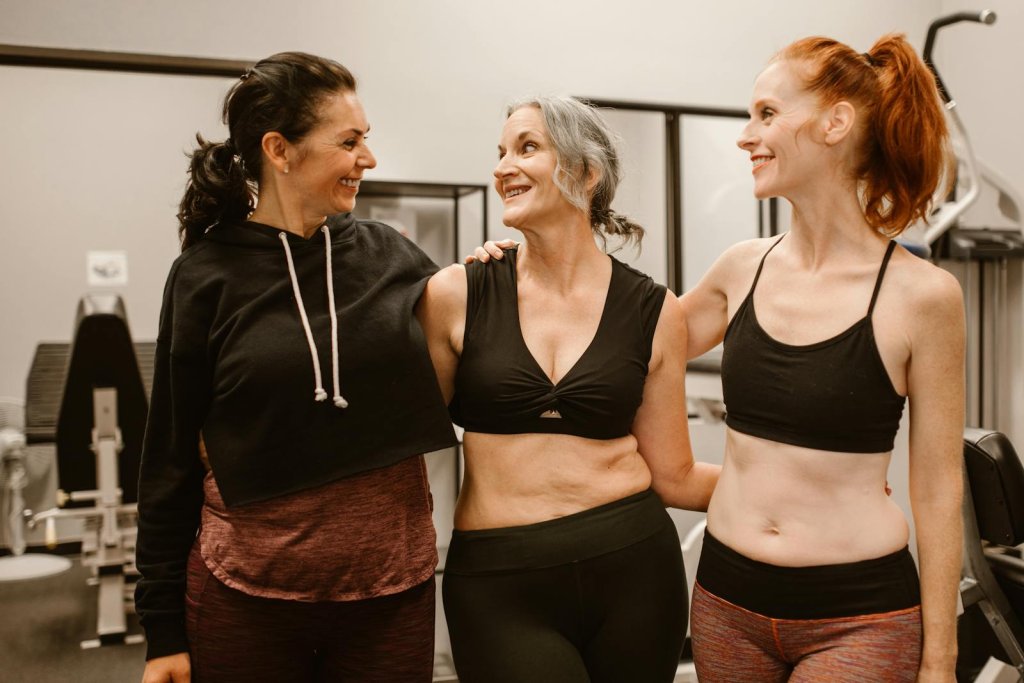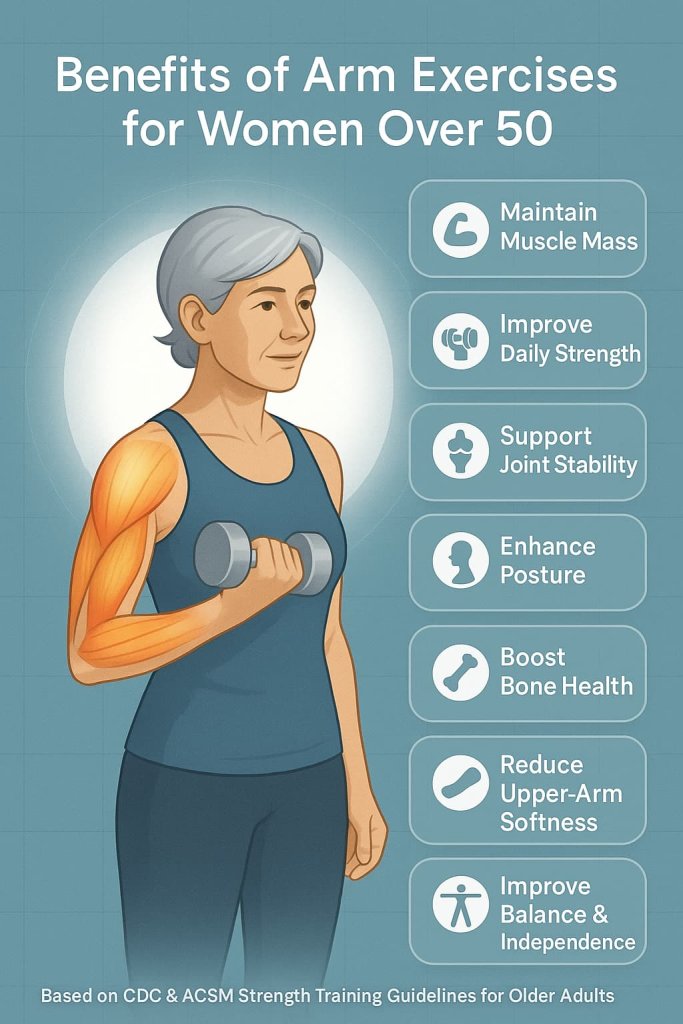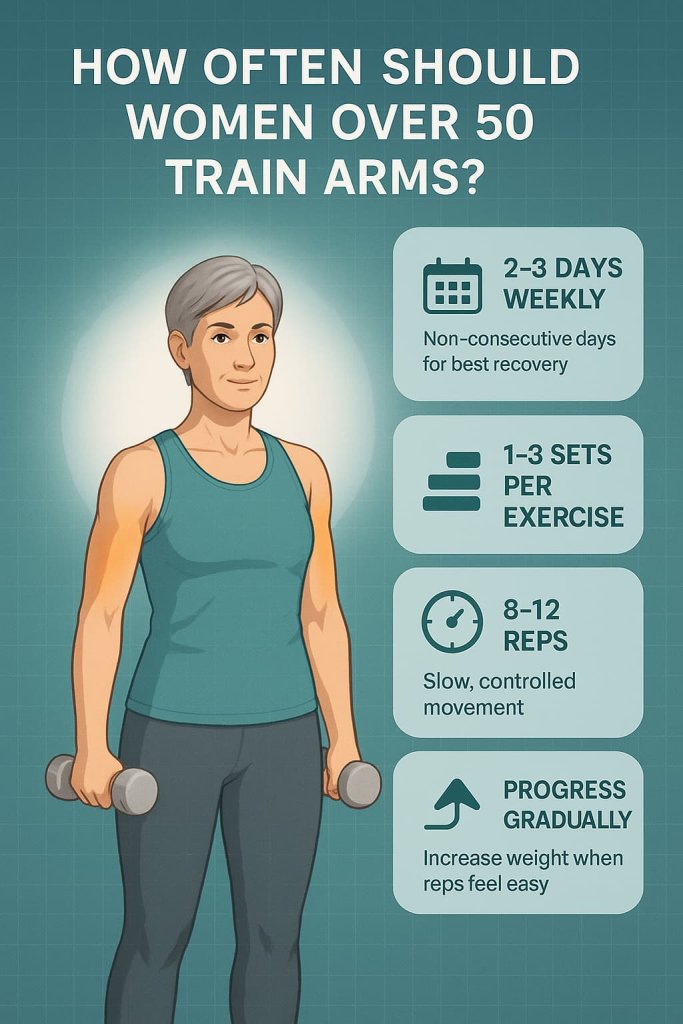Arm exercises for women over 50 help build strength, improve posture, and tighten the upper arms safely. These exercises may support better daily movement, protect joint health, and help counter age-related muscle loss.

After 50, women naturally experience decreased muscle mass, slower metabolism, and reduced bone density—especially after menopause. Strength training is one of the most effective ways to maintain strength, mobility, and independence. This guide explains the safest, most effective arm exercises women over 50 can do at home or the gym, along with technique, safety tips, equipment options, and recommended sets/reps.
Benefits of Arm Exercises for Women Over 50
Arm training after 50 provides several important health and functional benefits:
- Helps maintain lean muscle mass (supports healthy aging)
- Improves strength for daily tasks like lifting groceries or carrying bags

- Supports shoulder and elbow joint stability
- Enhances posture by strengthening arms, upper back, and shoulders
- Supports bone strength during and after menopause
- May help reduce upper-arm softness with consistent training
- Contributes to better balance and overall independence
Research Insight: Resistance training 2–3 times per week is recommended for older adults to maintain strength, bone density, and mobility (based on CDC & ACSM guidance, which specify at least 2 days per week of muscle-strengthening activity).
How Often Should Women Over 50 Train Arms?

- 2–3 days per week, non-consecutive
- 1–3 sets per exercise when starting out
- 8–12 repetitions for strength and toning
- Use slow, controlled movements
- Increase weight gradually when the last few reps feel easy
Warm-Up Before You Begin
A simple warm-up improves joint mobility and reduces injury risk.

2–3 Minute Warm-Up:
- Arm circles – 20 seconds
- Shoulder rolls – 10 each direction
- Light marching – 30 seconds
- Gentle biceps squeeze/stretch – 10 seconds
- Elbow flexion/extension – 15 reps
12 Best Arm Exercises for Women Over 50 (Beginner & Joint-Friendly Options)
These exercises are safe, effective, and easy to perform at home using light dumbbells or resistance bands. Each move is designed to strengthen your arms, protect your joints, and support healthy, confident movement after 50.
1. Biceps Curls
Strengthens the front of the arms and supports everyday lifting tasks.
Why it works:
Biceps curls isolate the biceps and help maintain upper-arm strength, which naturally declines after age 50. This exercise supports daily activities like carrying groceries, lifting objects, and improving arm firmness.
Muscles worked:
- Biceps brachii
- Brachialis
- Forearms (secondary)
How to do it:
- Stand or sit tall with dumbbells at your sides
- Keep elbows close to your torso
- Curl the weights up slowly
- Pause at the top
- Lower under control
Trainer Tip:
Choose a weight you can lift without swinging. Slower reps increase muscle activation and joint safety.
2. Hammer Curls
A wrist-friendly variation perfect for beginners.
Why it works:
Hammer curls reduce strain on the wrists and elbows, making them ideal for women experiencing joint sensitivity. The neutral grip strengthens both the biceps and deeper arm muscles that support grip and daily function.
Muscles worked:
- Biceps brachii
- Brachioradialis
- Forearms
How to do it:
- Hold weights with palms facing inward
- Keep elbows still as you curl
- Lift until forearms are vertical
- Pause briefly
- Lower slowly
Trainer Tip:
Keep shoulders relaxed—avoid shrugging to prevent neck tension.
3. Seated Biceps Curls (Chair-Supported)
Best for women with balance concerns.
Why it works:
Sitting eliminates balance challenges, allowing full focus on proper technique. It also prevents using momentum, creating better muscle engagement.
Muscles worked:
- Biceps brachii
- Brachialis
How to do it:
- Sit tall with back supported
- Hold dumbbells at your sides
- Curl up slowly
- Avoid swinging
- Lower under control
Trainer Tip:
Keep feet flat and core engaged to support the lower back.
4. Overhead Triceps Extensions
Targets the back of the arms (a common trouble area).
Why it works:
This movement deeply activates the long head of the triceps, helping tighten and tone the back of the upper arms. It also assists with overhead strength and daily reaching tasks.
Muscles worked:
- Triceps (long head emphasized)
- Shoulders (stabilizers)
How to do it:
- Hold one dumbbell overhead
- Keep elbows close to your head
- Bend elbows to lower weight behind your head
- Extend back up without arching your back
Trainer Tip:
If overhead motions cause discomfort, switch to triceps kickbacks instead.
5. Triceps Kickbacks
Low-impact tricep move ideal for stabilizing the upper arm.
Why it works:
Kickbacks target all three heads of the triceps with minimal strain on shoulders. They help tone the back of the arms and support everyday pushing movements.
Muscles worked:
- Triceps brachii
- Rear deltoids (stabilizers)
How to do it:
- Lean forward slightly
- Bend elbows to 90 degrees
- Kick arms back until straight
- Pause
- Return slowly
Trainer Tip:
Keep upper arms still—only your forearms should move for proper form.
6. Resistance-Band Triceps Press-Down
Excellent shoulder-friendly triceps work.
Why it works:
This band exercise protects the shoulders and wrists while effectively isolating the triceps. It’s especially beneficial for women managing joint stiffness.
Muscles worked:
- Triceps
- Core (stabilization)
How to do it:
- Anchor the band at head height
- Hold the band with elbows tucked
- Straighten elbows to pull down
- Keep shoulders relaxed
- Return slowly
Trainer Tip:
Avoid leaning forward—stay tall to maximize triceps activation.
7. Lateral Raises
Strengthens shoulders and improves posture.
Why it works:
Lateral raises build the middle shoulder muscles, helping improve posture and prevent shoulder rounding—a common issue with aging.
Muscles worked:
- Lateral deltoids
- Upper trapezius (secondary)
How to do it:
- Hold dumbbells at sides
- Raise arms to shoulder height
- Keep elbows slightly bent
- Lower with control
Trainer Tip:
If weights feel heavy, use lighter dumbbells—shoulder exercises require less weight.
8. Front Raises
Targets the front shoulders and enhances lifting strength.
Why it works:
Front raises strengthen the front deltoids, which assist in reaching, lifting, and carrying tasks. Ideal for improving overhead and forward lifting ability.
Muscles worked:
- Anterior deltoids
- Upper chest (secondary)
How to do it:
- Hold dumbbells in front of your thighs
- Raise arms to shoulder height
- Pause
- Lower slowly
Trainer Tip:
Lift with control—avoid swinging weights upward.
9. Seated Shoulder Press
Best for improving overhead strength safely.
Why it works:
Seated pressing strengthens the shoulders while providing back support. It builds practical strength for real-life tasks like placing items on shelves.
Muscles worked:
- Deltoids
- Triceps
- Upper back (stabilizers)
How to do it:
- Sit upright with dumbbells at shoulder height
- Press weights overhead
- Lower with control
- Keep core engaged
Trainer Tip:
If overhead motions are uncomfortable, keep the elbow angle smaller or switch to lateral raises.
10. Wall Push-Ups
A joint-friendly push variation.
Why it works:
Wall push-ups reduce wrist and shoulder strain while strengthening the arms, chest, and shoulders. Perfect for beginners or those with limited upper-body strength.
Muscles worked:
- Chest
- Triceps
- Shoulders
- Core (secondary)
How to do it:
- Stand facing a wall
- Place hands shoulder-width apart
- Bend elbows to lower chest toward wall
- Push back to starting position
Trainer Tip:
Move feet further back to make it slightly more challenging.
11. Incline Push-Ups (Counter or Table)
A progression from wall push-ups.
Why it works:
Incline push-ups increase intensity without stressing joints. Excellent for improving upper-body strength gradually.
Muscles worked:
- Chest
- Triceps
- Shoulders
- Core
How to do it:
- Place hands on a counter or table
- Walk feet back
- Lower chest toward the counter
- Push up to the start
Trainer Tip:
Maintain a straight line from head to heels to protect your lower back.
12. Resistance-Band Rows
Great for arms, mid-back, posture, and shoulder health.
Why it works:
Rows strengthen the muscles that counteract shoulder rounding, helping improve posture. They also train the biceps and back without compressing the joints.
Muscles worked:
- Upper back
- Rear deltoids
- Biceps
How to do it:
- Sit or stand with the band anchored in front
- Hold handles and pull toward your ribs
- Squeeze shoulder blades
- Return slowly
Trainer Tip:
Focus on pulling with your back muscles, not just your arms, for better posture improvements.
Weekly Arm Workout Plan for Women Over 50 (Beginner-Friendly)
Train 2–3 times per week
Day Example:
- Biceps Curls – 12 reps
- Triceps Extensions – 12 reps
- Lateral Raises – 10 reps
- Shoulder Press – 10 reps
- Wall Push-Ups – 8–12 reps
- Band Rows – 12 reps
Repeat 1–2 times depending on ability.
Safety Tips for Women Over 50
- Start with light weights or resistance bands
- Avoid fast or jerky movements
- Keep shoulders relaxed and away from ears
- Avoid locking elbows
- Stop if you feel sharp or radiating pain
- If you have arthritis, osteoporosis, or heart conditions, consult a healthcare provider before starting
- Progress slowly over weeks, not days
FAQ – Arm Exercises for Women Over 50
1. Can women over 50 tone their arms?
Yes. Strength training helps build muscle, improve firmness, and support healthy aging.
2. How long does it take to see results?
Most women notice improved strength within 3–4 weeks and visible tone in 6–8 weeks with consistency.
3. What weight should beginners start with?
1–5 lb dumbbells or light/medium resistance bands are ideal when starting.
4. Are these exercises safe for shoulder issues?
Yes—just avoid overhead movements if painful and focus on band rows, curls, and wall push-ups.
5. How many times a week should women over 50 work out?
At least two strength sessions per week.
6. Can these exercises help with “bat wings”?
They may help improve firmness and muscle tone, but results vary by consistency and genetics.
7. Do I need a gym?
No—these exercises can be done at home with dumbbells or bands.
Conclusion
Arm exercises for women over 50 are essential for strength, shape, posture, and independence. With just two to three weekly sessions, you can build stronger, firmer arms while supporting your overall health. Start light, stay consistent, and progress at a pace that feels safe and comfortable.
Ready to begin? Start with 3–4 exercises and build your routine from there.
References
- CDC – Adult Activity: An Overview (Physical Activity Guidelines for Adults)
https://www.cdc.gov/physical-activity-basics/guidelines/adults.html - Physical Activity Guidelines for Americans, 2nd Edition (Full PDF)
https://health.gov/sites/default/files/2019-09/Physical_Activity_Guidelines_2nd_edition.pdf - World Health Organization – Physical Activity Recommendations (Adults & Older Adults)
https://www.who.int/initiatives/behealthy/physical-activity - Hurst C. et al. (2022) – Resistance Exercise as a Treatment for Sarcopenia: Prescription and Delivery (Age and Ageing)
https://academic.oup.com/ageing/article/51/2/afac003/6527381
